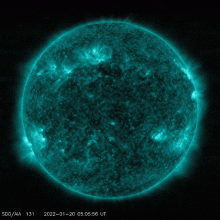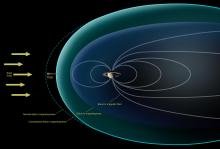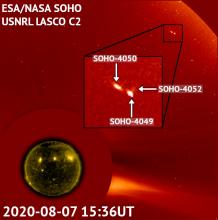Listen to today's episode of StarDate on the web the same day it airs in high-quality streaming audio without any extra ads or announcements. Choose a $8 one-month pass, or listen every day for a year for just $30.
You are here
Solar Rain
Big storms bring big rains at this time of year. It rains on the Sun, too, mainly during its own stormy season.
The Sun produces big magnetic storms on its surface. The number varies across an 11-year cycle. At its minimum, the Sun can be storm free for days or even weeks. But at its peak, the cycle can produce dozens of dark sunspots, plus many big outbursts of particles and radiation.
Those outbursts blast billions of tons of hot gas out into space. Some of that material escapes into the solar system, where it can affect Earth and the other planets. On Earth, it can knock down satellites, cause power blackouts, and block some forms of radio communications.
But some of it forms big loops that trace out a storm’s magnetic field. And much of that material can “rain” back down on the Sun.
A recent study looked at that hot rain. It was the first study to compare the length and intensity of the rainfall to the power of the storms. It found that the rain can last anywhere from an hour to more than three days. The longest rains were produced by the most powerful storms. And storms of low intensity produced little or no rain at all.
That suggests that studying the rainfall can tell us more about the energy produced by the storms themselves. It might also tell us more about the Sun’s long magnetic cycle, and even contribute to predictions of the intensity of coming cycles — helping forecast more rainfall on the surface of the Sun.
Script by Damond Benningfield





